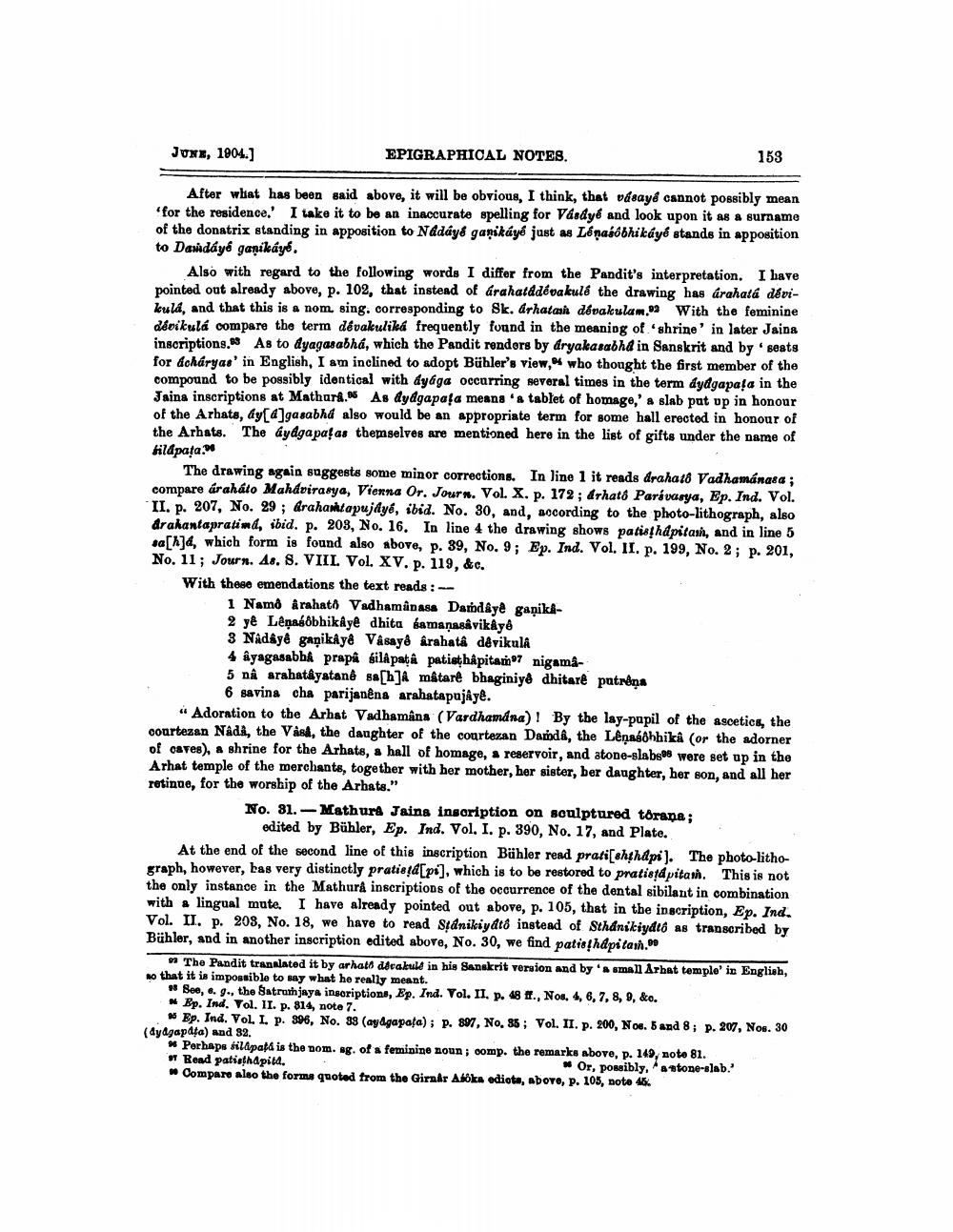________________
JUNE, 1904.]
EPIGRAPHICAL NOTES.
153
After what has been said above, it will be obvious, I think, that vásayê cannot possibly mean 'for the residence, I take it to be an inaccurate spelling for Vásdye and look upon it as a surname of the donatrix standing in apposition to Nadáyê ganikaye just as Lénaáóbhikáyd stands in apposition to Daddy ganikaye.
Also with regard to the following words I differ from the Pandit's interpretation. I have pointed out already above, p. 102, that instead of arahatddévakuld the drawing has árahatá dévikuld, and that this is a nom. sing. corresponding to Sk. arhatari dbvakulam. With the feminine dévikulá compare the term dévalulika frequently found in the meaning of shrine' in later Jaina inscriptions. As to dyagasabhá, which the Pandit renders by dryakasabha in Sanskrit and by seats for acharyas' in English, I am inclined to adopt Bühler's view, who thought the first member of the compound to be possibly identical with dybga occurring several times in the term dydgapaļa in the Jaina inscriptions at Mathura. As dydgapaţa means 'a tablet of homage,' a slab put up in honour of the Arbats, ay[4]gasabhd also would be an appropriate term for some hall erected in honour of the Arhats. The kydgapaļas themselves are mentioned here in the list of gifts under the name of fildpața.
The drawing again suggests some minor corrections. In line 1 it reads drahat8 Vadhamanasa; compare áraháto Mahdvirasya, Vienna Or. Journ. Vol. X. p. 172; drható Parivasya, Ep. Ind. Vol. II. p. 207, No. 29 ; Qraha tapujayé, ibid. No. 30, and, according to the photo-lithograph, also drakantapratind, ibid. p. 203, No. 16. In line 4 the drawing shows patisshapitash, and in line 5 sa[k]d, which form is found also above, p. 39, No. 9; Ep. Ind. Vol. II. p. 199, No. 2; p. 201, No. 11; Journ. As. S. VIIL Vol. XV. p. 119, &c. With these emendations the text reads : --
1 Namo Arahati Vadhamanasa DardAye ganika2 yê Lêņabobhikâye dhita samaņasávikâye 3 Nádayê ganikayê Vásayé arahata dêvikula 4 âyagasabbk prapa silapatâ patiethâpitaxo7 nigama5 na arahatkyatane sa[h]A mätare bhaginiyê dhitare patróna
6 savina cha parijanêna arahatapujâye. « Adoration to the Arhat Vadhamans (Vardhamdna)! By the lay-papil of the ascetics, the courtezan Nada, the Vase, the daughter of the courtezan Darda, the Lêņaáðhhika (or the adorner of caves), a shrine for the Arhats, a hall of homage, a reservoir, and atone-slabs were set up in the Arhat temple of the merchants, together with her mother, her sister, ber daughter, her son, and all her retinde, for the worship of the Arbats."
No. 81.-Mathura Jains inscription on sculptured torana;
edited by Bühler, Ep. Ind. Vol. I. p. 390, No. 17, and Plate. At the end of the second line of this inscription Bühler read prati[shthdpi). The photo-lithograph, however, bas very distinctly pratietd[pr], which is to be restored to pratista pitan. This is not the only instance in the Mathura inscriptions of the occurrence of the dental sibilant in combination with a lingual mute, I have already pointed out above, p. 105, that in the inscription, Ep. Ind. Vol. II. p. 208, No. 18, we have to read Stånikiyat instead of Sthanikiydto as transcribed by Bühler, and in another inscription edited above, No. 30, we find patioth&pitan."
The Pandit translated it by arhat ddrakult in his Sanskrit veruion and by 'small Arbat temple' in English, no that it is impossible to say what he really meant.
* Boo, 9., the Batruhjaya insoriptions, Ep. Ind. Vol. II, p. 48 t., No. 4, 6, 7, 8, 9, &o. * Ep. Ind. Vol. II. p. 814, note 7.
* Ep. Ind. VOL. I. p. 396, No. 38 (ayAgapata); p. 897, No. 88; Vol. II. p. 200, No. 8 and 8; p. 207, Nos. 30 (dy&gapdta) and 32.
w Perhaps silapad is the pom. sg. of a feminine noun; comp. the remarks above, p. 149, noto 81. * Read patisthapita.
Or, possibly, antone-slab.' Compare also the forma quoted from the Girner Asöka odiote, ADOTO, P. 105, note 45




